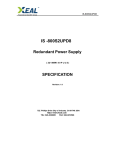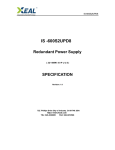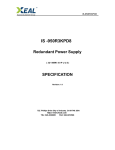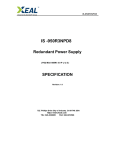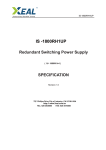Download iStarUSA IS-700S2UPD8 power supply unit
Transcript
IS-700S2UPD8 IS -700S2UPD8 Redundant Power Supply ( 2U- 700W 8 0 P L U S ) SPECIFICATION Revision: 1.0 727 , . Phillips Drive City of Industry. CA 91748. USA http:// www.Xeal.com TEL: 626-3038885 FAX: 626-3010588 1. Purpose This specification defines the performance characteristics and functions of a 700 watts 2U form factor of switch mode power supply with Active PFC (Power Factor Correction) and PMBus function. 2. AC Input Requirements 2.1 Input Voltage and Frequency Voltage (sinusoidal) : 100~240 VAC full range, with 10% tolerance. Input frequency ranges from 47hz~63hz 2.2 AC Input Current and Inrush Current AC line inrush current shall not damage any component nor cause the AC line fuse to blow under any DC conditions and with any specified AC line input voltage and frequency. Repetitive On/Off cycling of the AC input voltage shall not damage the power supply. Table 1: AC Input Current and Inrush Current 2.3 Input Voltage Maximum Input Current Maximum Inrush Current 100~240Vac 10A~6A 60Apeak@115VAC Input Power Factor Correction (Active PFC) The power factor at 100% of rated load shall be ≥ 0.97 at nominal input voltage. 2.4 AC Line Transient Specification AC line transient conditions are characterized as “sag” and “surge” conditions. Sag conditions (also referred to as “brownout” conditions) will be defined as the AC line voltage dropping below nominal voltage. Surge conditions will be defined as the AC line voltage rising above nominal voltage. The power supply shall meet the regulation requirements under the following AC line sage and surge conditions. Table 2: AC Line Sag Transient Performance Duration Sag Operating AC Voltage Line Frequency Load Performance Criteria Continuous 10% Nominal AC Input ranges 50/60 Hz 100% No loss of function or performance 0-1 AC cycle 100% Nominal AC Input ranges 50/60 Hz 80% No loss of function or performance > 1 AC cycle > 10% Nominal AC Input ranges 50/60 Hz 100% Loss of function Acceptable, Table 3: AC Line Surge Transient Performance Duration Surge Operating AC Voltage Line Frequency Performance Criteria Continuous 10% Nominal AC Voltage 50/60 Hz No loss of function or performance 0 - ½ AC cycle 30% Mid-point of Nominal AC Voltage 50/60 Hz No loss of function or performance 3. DC Output Specification 3.1 Output Power / Currents Voltage Table 4: Load Range Minimum Continuous Load Maximum Continuous Load1,3 +3.3V 0.5A 25A +5V 0.5A 25A +12V 0.8A 57A -12V 0.1A 0.5A +5VSB 0.1A 3.5A Notes: 1: The +3.3 &+5 Volt total outputs shall not exceed 150W. 2: Noise bandwidth is from DC to 20 MHz 3.2 Voltage Regulation, Ripple and Noise Table 5: Regulation, ripple and noise Output Voltage +3.3V +5V +12V -12V +5VSB Load Reg. ±5% ±5% ±5% ±5% ±5% Line Reg. ±1% ±1% ±1% ±1% ±1% Ripple & Noise 60mV 60mV 120mV 120mV 60mV Ripple and noise shall be measured using the following methods: a) Measurements made differentially to eliminate common-mode noise b) Ground lead length of oscilloscope probe shall be ≤ 0.25 inch. c) Measurements made where the cable connectors attach to the load. d) Outputs bypassed at the point of measurement with a parallel combination of 10uF tantalum capacitor in parallel with 0.1uF ceramic capacitors. e) Oscilloscope bandwidth of 0 Hz to 20MHz. f) Measurements measured at locations where remote sense wires are connected. g) Regulation tolerance shall include temperature change, warm up drift and dynamic load 3.3 Capacitive Loading The power supply shall be stable and meet all requirements in the following table, except dynamic loading requirements. Table 6: Capacitive Loading Conditions 3.4 Output MIN MAX Units +3.3V 10 12,000 uF +5V 10 12,000 uF +12V 10 11,000 uF -12V 1 350 uF +5VSB 1 350 uF Dynamic Loading The output voltages shall remain within the limits specified in Table-Regulation, ripple and noise for the step loading and within the limits specified in Table-Transient Load Requirement for the capacitive loading. The load transient repetition rate shall be tested between 50Hz and 5kHz at duty cycle ranging from 10%-90%. The load transient repetition rate is only a test specification. The step load may occur anywhere within the MIN load to the MAX load shown in Table-Load Range. Table 7: Transient Load Requirements Step Load Size Load Slew Rate Output 3.5 Capacitive Load +5V 30% of Max. Load 0.5 A/uS 1000 uF +3.3V 30% of Max. Load 0.5 A/uS 1000 uF +12V 50% of Max. Load 0.5 A/uS 2200 uF +5VSB 30% of Max. Load 0.5 A/uS 1 uF Overshoot at Turn-on/Turn-off Any output overshoot at turn on shall be less than 10% of the nominal output value. Any overshoot shall recover to be within regulation requirements in less than 10ms. 3.6 Timing Requirements Table 8: Output Voltage Timing MIN MAX Units Output voltage rise time from each main output 1 30 mS Output voltage rise time for the 5Vsb out put 1 25 mS Item Description Tvout_rise Tvout_on All main output must be within regulation of each other within this time. 50 mS Tvout_off All main output must leave regulation within this time 400 mS Figure 1: Output Voltage Timing Vout V1 10% Vout V2 V3 V4 Tvout_on Tvout_off Tvout_rise Table 9: Turn On/Off Timing Item Description MIN MAX Units Tsb_on-delay Delay from AC being applied to +5VSB being within regulation. 1500 mS Tac_on-delay Delay from AC being applied to all output voltages being within regulation. 2500 mS Tvout_holdup Time all output voltage stay within regulation after loss of AC tested at 80% of maximum load. 17 mS Tpwok_holdup Delay from loss of AC deassertion of PWOK tested at 80% of maximum load. 16 mS Tpson_on_delay Delay from PSON# active to output voltage within regulation limits. 5 Tpson_pwok Delay from PSON# deactive to PWOK being deasserted. Tpwok_on Delay from output voltage within regulation limits to PWOK asserted at turn on. 100 Tpwok_off Delay from PWOK deasserted to output voltages (+5V, +3.3V, +12V, -12V) dropping out of regulation limits. 1 mS Tpwok_low Duration of PWOK being in the deasserted state during an off/on cycle using AC or the PSON# signal. . 100 mS Tsb_vout Delay from +5VSB being in regulation to O/Ps being in regulation at AC turn on. 50 400 mS 50 mS 1000 mS 1000 mS Figure 2: Turn On/Off Timing AC Input AC off AC On Tvout_holdup Vout Tac_on-delay Tpwok_low Tsb_on-delay PWOK Tpwok_on +5VSB Tsb_vout Tpwok_off Tpwok_holdup Tpwok_off Tsb_on-delay Tpwok_on Tpson_pwok Tsb_holdup Min.>70mS Tpson_on_delay PSON# AC turn 0n/off cycle 3.7 PSON turn on/off cycle Efficiency The minimum power supply system efficiency shall be 80% at typical load, measured at nominal input voltage 4. Protection Circuits Protection circuits inside the power supply shall cause only the power supply’s main outputs to shutdown. If the power supply latches off due to a protection circuit tripping, an AC cycle OFF for 15 sec and a PSON# cycle HIGH for 1 sec must be able to restart the power supply. 4.1 Over Current Protection (OCP) The power supply shall have current limit to prevent the +5V, +3.3V, and +12V outputs from exceeding the values shown in Table-Over Current Protection. The power supply shall latch off if the current exceeds the limit. Voltage Table 10: Over Current Protection Minimum Maximum Shutdown Mode +5V 110% 150% Latch Off +3.3V 110% 150% Latch Off +12V 110% 150% Latch Off 4.2 Over Voltage Protection (OVP) The power supply shall shut down and latch off after an over voltage conditions occurs. Table 11: Over Voltage Protection Voltage Minimum Maximum Shutdown Mode 4.3 +5V +5.7V +6.5V Latch Off +3.3V +3.9V +4.5V Latch Off +12V +13.3V +14.5V Latch Off Short Circuit Protection The power supply shall shut down in latch off mode when the output voltage is short circuit. 4.4 No Load Operation No damage or hazardous condition should occur with all the DC output connectors disconnected from the load. The power supply may latch into the shutdown state. 4.5 Over Temperature Protection (OTP) The power supply will shut down i when an over temperature condition occurs; no damage shall be caused. 5. Environmental Requirements 5.1 Temperature Operating Ambient, normal mode (inlet air): 0°C ~ 50°C (32°F~ 113°F) Non-operating Ambient:: -40°C ~ 70°C (-40°F~ 158°F) 5.2 Humidity Operating: 20% ~ 90%RH non-condensing Non-Operating: 5% ~ 95%RH non-condensing 5.3 Altitude Operating: Sea level to 10,000 ft Non Operating: Sea level to 40,000 ft 5.4 Mechanical Shock Non-Operating: 50 G Trapezoidal Wave, 11mS half sin wave. The shock is to be applied in each of the orthogonal axes. 5.5 Vibration (Non-Operating) The power supply shall be subjected to a vibration test consisting of a 10 to 300 Hz sweep at a constant acceleration of 2.0g for duration of one (1) hour for each of the perpendicular axes X, Y and Z (0.1 octave/minute). The output voltages shall remain within specification. 5.6 Electromagnetic Compatibility Electromagn etic Interference FCC CFR Title 47 Part 15 Sub Part B EN55022/EN55024 Harmonics IEC61000-3-2 Class D Flicker IEC61000-3-3 ESD Susceptibility EN-61000-4-2 Radiated Susceptibility EN61000-4-3 EFT/Burst EN61000-4-4 Surge Voltage EN61000-4-5 Conducted Susceptibility EN61000-4-6 RF Conducted Voltage Dips and Interruptions Leakage Current 5.7 Conducted B Class Radiated A Class 8KV by Air, 4KV by Contact Performance Criteria B 80MHz~1000MHz (3V/m(mns) Amplitude 80% AM 1KHz Criteria A 5KHz, AC: 1KV, DC: 0,5 KV, Performance Criteria B Line-to-Line: 1KV Line-to-Ground: 2KV Performance Criteria B 0.15MHz~80MHz 3V/m Amplitude 80% AM 1KHz Performance Criteria A EN61000-4-8 50 Hz/3A(ms)/m Performance Criteria A EN61000-4-11 30%(Voltage Dips) 10 ms 60%(Voltage Dips) 100ms >95%(Voltage Dips) 500ms EN60950-1 3.5mA@240VAC Criteria B Criteria C Criteria C Safety Agency Requirements This power supply is designed to meet the following safety Table X: Product Safety Product Safety: UL,cUL CB TUV CCC UL60950-1 IEC60950-1 EN60950-1 6. Reliability 6.1 Mean Time Between Failures (MTBF) The MTBF of the power supply shall be calculated utilizing the Part-Stress Analysis method of MIL217F. The calculated MTBF of the power supply shall be greater than 100,000 hours under the following conditions: Full rated load; 120V AC input; Ground Benign; 25°C 7. PMBus Command Codes Command Summary Note1: If AC Input= 90V ~ 180V PMBus sent the value of 115V If AC Input= 181V ~ 264V PMBus sent the value of 230V Command Code Command Name SMBus Transaction Type 19h 1Ah 88h 89h 8Bh 8Ch 8Dh 90h 91h 96h 97h 98h 99h 9Ah 9Bh 9Eh A0h A1h A7h B0h CAPABILITY QUERY READ_VIN(Note1) READ_IIN READ_VOUT READ_IOUT READ_TEMPERATURE_1 READ_FAN_SPEED_1 READ_FAN_SPEED_2 READ_POUT READ_PIN PMBUS_REVISION MFR_ID MFR_MODEL MFR_REVSION MFR_SERIAL MFR_VIN_MIN MFR_VIN_MAX MFR_POUT_MAX USER_DATA_00 Read Byte Read Byte READ WORD READ WORD READ WORD READ WORD READ WORD READ WORD READ WORD READ WORD READ WORD READ BYTE R/W Block R/W Block R/W Block R/W Block READ_WORD READ_WORD READ_WORD READ BYTE Number of Data Bytes 1 1 2 2 2 2 2 2 2 2 2 1 Variable Variable Variable Variable 2 2 2 1 MFR Meaning Command Code 99h 9Ah 9Bh 9Eh A0h A1h A7h Command Name MFR_ID MFR_MODEL MFR_REVSION MFR_SERIAL MFR_VIN_MIN MFR_VIN_MAX MFR_POUT_MAX Meaning ETASIS EFRP-S703 A0 ~ Z9 Code = 12 100VAC 240VAC 700W Status BYTE Message Contents Command code = B0h (Command name = USER_DATA_00) Bit Number 7 6 Status Bit Name Reserved Reserved Meaning Default=0 Default=0 5 4 3 2 1 0 Reserved Reserved Reserved Module Status PS_ON Status AC Status Device address locations PDB adderss A0/A1 PSU PMBUS Device 0/0 B0h Default=0 Default=0 Default=0 Inserted=0, Not inserted=1 PS_OFF=0, PS_ON=1 AC OK=0, AC Fail=1 0/1 B2h 1/0 B4h 8. LED Indicators There will be a LED on each power module to indicate power status Power Supply Status Works Normally Standby (Only +5VSB output) Power Fail Fan Fail Color Green Blinking Green Red Blinking Red 9. Signals from Wire Harness Power Supply Status Works Normally Power Fail Fan Fail Alarm reset is used to clear power fail status by shorting circuit activities. Buzzer shall alarm if signal goes low. 10. Mechanical Overview Dimension: 101.8mm(W) x 83.4mm(H) x 280mm(D) Weight: 4.8 Kg Signal Type High Low Low 1/1 B6h











